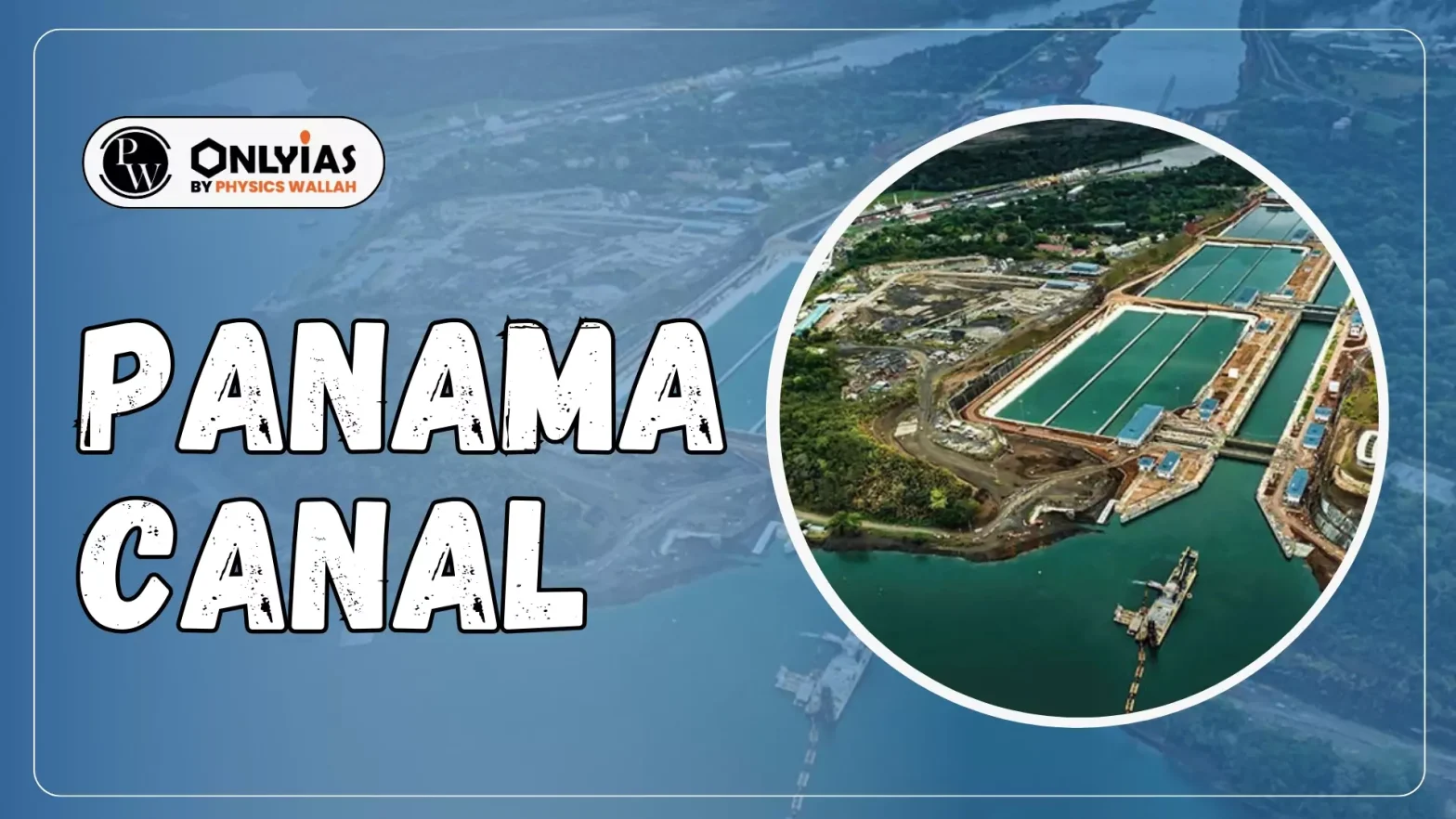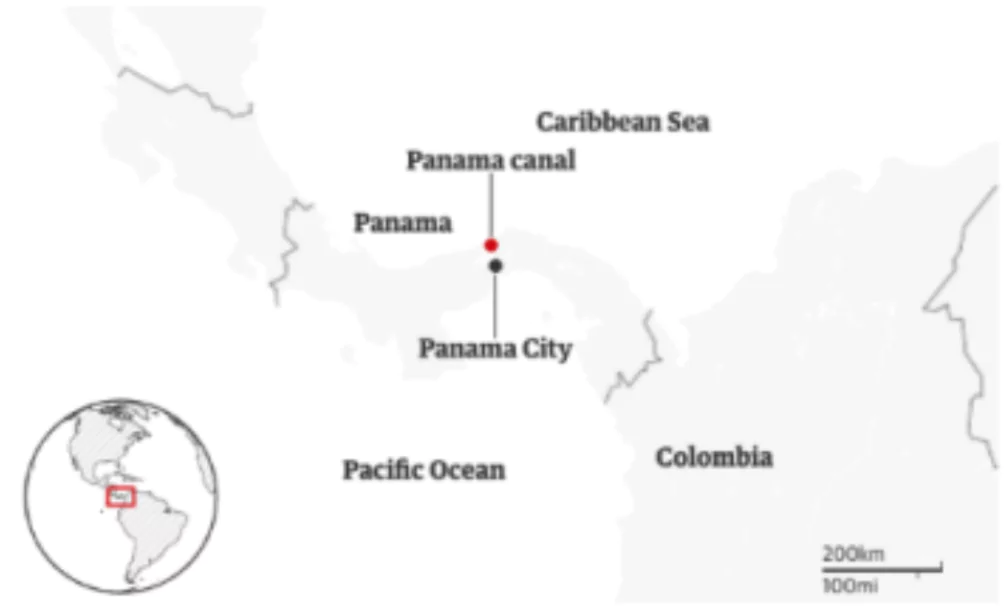Panama Canal is an artificial waterway that connects the Atlantic Ocean with the Pacific Ocean. Learn more about its history, key facts, and significance.

The Panama Canal is a man-made waterway that connects the Atlantic Ocean and the Pacific Ocean. It facilitates faster maritime trade routes by eliminating the need to navigate around the southern tip of South America. The Panama Canal continues to be a strategic waterway, crucial for global trade and geopolitics, making it a significant topic for UPSC aspirants. Keep on reading to know what is Panama Canal, its map, its history, and its impact.
Located in the country of Panama, this 82 km (51-mile) canal is a vital engineering marvel and a crucial link in global trade. Constructed to provide a shortcut for ships, the canal significantly reduces travel time between the eastern and western coasts of the Americas. The Panama Canal plays an important role in geopolitics, trade, and economics, making it a relevant topic for the UPSC exam.
Key Facts about the Panama Canal |
|
|---|---|
| Feature | Details |
| Location | Panama (Central America) |
| Connects | Atlantic Ocean (via the Caribbean Sea) and Pacific Ocean |
| Length | Approximately 82 km (51 miles) |
| Depth | 12.5 meters (41 feet) |
| Width | Approximately 300 meters (984 feet) |
| Built By | Initially by the French; completed by the United States |
| Year Built | Completed in 1914 |
| Purpose | To reduce maritime travel time and connect trade routes across the Americas |
| Time to Cross | Takes about 8-10 hours for ships to pass through the canal |
| Importance | Critical for global trade, connecting two major oceans and continents |
The construction of the Panama Canal began in the late 19th century. Initially, the French started the project in 1881, but due to challenges like tropical diseases and engineering difficulties, the project was abandoned. Later, in 1904, the United States took over and completed the canal in 1914. This ambitious project overcame obstacles such as rough terrain, dense jungles, and harsh weather conditions, marking a significant achievement in civil engineering.
The canal’s construction also required significant geopolitical negotiations, as the area was under Colombian jurisdiction before Panama declared independence with U.S. support in 1903. The U.S. gained control of the canal zone under the Hay-Bunau-Varilla Treaty, but full control was handed back to Panama in 1999 under the Torrijos-Carter Treaties.
On a world map, the canal is a small yet crucial passage connecting the Atlantic Ocean (via the Caribbean Sea) to the Pacific Ocean. The Panama Canal serves as a natural bridge between North America and South America. It links the Atlantic Ocean and the Pacific Ocean, creating a vital shortcut for maritime trade. Check the Panama Canal Map to understand it better:

Before the canal, ships had to traverse the dangerous Cape Horn route around South America, which was time-consuming and hazardous. Therefore, this canal was built to:
The Panama Canal has recently been in the news due to statements made by U.S. President-elect Donald Trump regarding its control and management. Key developments include:
Reclamation Threat: President-elect Trump has expressed intentions to reclaim the Panama Canal for the United States, criticizing the fees charged by Panama for canal transit as exorbitant. He suggested that if these fees are not adjusted, the U.S. might demand the canal’s return.
Concerns Over Chinese Influence: Trump has raised concerns about potential Chinese involvement in the management of the canal’s ports of entry, viewing it as a violation of the 1977 treaty that transferred control to Panama. He emphasized that the canal should not be under Chinese management.
Panama’s Response: Panamanian President José Raúl Mulino firmly rejected Trump’s statements, asserting that the canal is an inalienable part of Panama’s sovereignty. He emphasized that the canal’s fees are determined based on market conditions and the need for maintenance and modernization. Mulino stated that the canal belongs to Panama and will continue to do so.
Historical Context: The Panama Canal was under U.S. control until its transfer to Panama on December 31, 1999, following a 1977 agreement between Presidents Jimmy Carter and Omar Torrijos. It has since been managed by the Panama Canal Authority, which answers to the Panamanian government.
Global Trade Significance: The Panama Canal is a vital conduit for international maritime trade, handling a significant portion of global shipping traffic. Any changes in its management or control could have far-reaching implications for global trade routes and economic relations.
The Panama Canal, a pivotal conduit for global maritime trade, is facing significant operational challenges due to climate change-induced environmental shifts. The following table outlines the key impacts:
| Impact | Details |
| Prolonged Drought | Since early 2023, the canal has been experiencing an extended drought. Notably, October 2023 recorded a 43% deficit in rainfall, marking it as the driest October since the 1950s. |
| Reduced Ship Traffic | The drought has led to a decrease in daily ship transits, dropping to as low as 22 ships per day in December 2023, compared to the usual 36 to 38 ships. This reduction is attributed to diminished water levels in Lake Gatun, a crucial water source for the canal’s operations. |
| Size Restrictions on Vessels | Lower water levels have necessitated limitations on the size of ships permitted to navigate the canal. Larger vessels, which require more water for buoyancy and lock operations, face increased risks of grounding in shallower waters, prompting these restrictions. |
| Global Trade Disruptions | Handling approximately 5% of global shipping traffic, the canal’s operational constraints have significant repercussions on international trade, leading to delays and rerouting of maritime logistics. |
| Shift to Alternative Routes | The water scarcity has compelled vessels traveling from Asia to the U.S. to opt for the Suez Canal, adding approximately six extra days to their journey compared to the Panama Canal route. |
Ready to boost your UPSC 2025 preparation? Join PW’s UPSC online courses today!
UPSC Exam 2025 Related Articles
UPSC Prelims 2025 Exam
UPSC Notification 2025
UPSC Preparation 2025
UPSC Eligibility 2025
UPSC Exam Pattern
UPSC Syllabus
The Panama Canal is an artificial waterway in Panama that connects the Atlantic and Pacific Oceans, facilitating global maritime trade.
The canal was completed in 1914 after construction began in the late 19th century.
The canal is approximately 82 km (51 miles) long.
It was built to reduce shipping time, enhance global trade, and provide a strategic maritime shortcut between two major oceans.
The average depth of the canal is 12.5 meters (41 feet), accommodating large cargo ships.

<div class="new-fform">
</div>